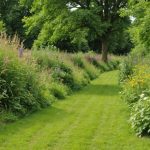Importance of Hedgerows in Sustainable Farming
Hedgerows play a crucial role in fostering biodiversity within agricultural landscapes. Serving as natural habitats, they significantly contribute to sustainable farming by offering refuge and resources for varied wildlife species. This approach not only enhances biodiversity but also aids in maintaining ecological balance.
Historically, hedgerows have been integral to UK farming practices, acting as natural boundaries and essential wildlife corridors. They have long been recognized for their role in pest control, offering a home to predators of agricultural pests, reducing the need for chemical interventions. This historical significance emphasizes the timeless utility and environmental benefits of hedgerows in farming.
Also to discover : Preserving the past: a deep dive into the uk”s initiatives and strategies for protecting ancient trees
In addition to these ecological roles, hedgerows provide additional benefits by preventing soil erosion and improving water retention. These advantages make them indispensable in promoting sustainable farming techniques. By encouraging natural pollinators and beneficial insects, hedgerows play a pivotal role in increasing crop yields naturally.
To ensure their continuous contribution, it’s essential that farmers and policymakers prioritize the preservation and restoration of hedgerows in sustainable farming strategies. Their multifaceted benefits showcase why hedgerows remain a cornerstone of environmentally-friendly agricultural practices.
In the same genre : Revitalize your garden: the ultimate guide for uk homeowners to create a wildlife-friendly paradise with native plants
Innovative Hedgerow Management Techniques
The role of hedgerow management is vital in preserving natural habitats and promoting ecological balance. By using effective planting techniques, biodiversity enhancement can be achieved. One approach to enhance biodiversity is the careful selection of native species known to thrive in local conditions. These species support local wildlife better and require less maintenance once established.
Maintaining and managing hedgerow health involves techniques like strategic pruning, which encourages new growth and helps maintain the hedgerow’s structure and function. Regular inspections and interventions, such as removing invasive species, contribute to long-term health.
Creating multi-layered hedgerows is another significant management technique. These multi-layered structures consist of diverse heights and plant types, offering varied habitats and food sources for different species. Trees, shrubs, and ground cover plants are combined to mimic natural layers found in forests, thereby increasing habitat diversity.
These methods not only improve hedgerow resilience but also enhance their role as wildlife corridors, which are crucial for species movement and genetic exchange. Moreover, adopting these innovative techniques ensures that hedgerows remain effective in environmental conservation, providing practical solutions to contemporary ecological challenges.
Case Studies of Successful Hedgerow Integration
In the UK, hedgerow strategies have led to a variety of exemplary projects that illustrate their benefits to both farm productivity and local wildlife. One particularly successful case study involves a farm in South West England, where hedgerow planting has increased crop yields by 10%. By creating windbreaks and improving soil fertility, hedgerows have significantly boosted productivity. Furthermore, they serve as critical habitats for species like hedgehogs and songbirds, enhancing the ecosystem.
Another notable project is an Oxfordshire farm, which demonstrated hedgerows’ ability to control erosion and conserve moisture, benefiting both crops and the surrounding environment. Farmers have reported less soil degradation and improved water retention. The adoption of these methods has also fostered stronger biodiversity corridors, essential for maintaining wildlife populations.
Farmers who have embraced hedgerow strategies often share positive testimonials about their experiences. One farmer stated, “Integrating hedgerows was transformative for our farm. We’ve seen a marked improvement in both yield and biodiversity.” This sentiment resonates across many testimonials from those employing these strategies, further validating their effectiveness. Clearly, the integration of hedgerow strategies into UK farms presents numerous advantages, making them a viable choice for sustainable agriculture.
Environmental Policies Supporting Hedgerow Initiatives
In the United Kingdom, environmental policies are increasingly aimed at promoting sustainable agriculture through hedgerow conservation. The government has implemented various initiatives to encourage the growth and maintenance of hedgerows, vital for enhancing biodiversity and ecosystem health.
One significant measure is the provision of funding and grants to farmers. These financial incentives support landowners willing to adopt hedgerow planting and restoration practices. Such programs are designed to reduce the economic burden and encourage farmers to integrate these practices into their agricultural activities, ultimately facilitating a sustainable agricultural landscape.
Moreover, the UK’s approach is part of a broader trend observed across Europe. Countries within the European Union have also established policies targeting hedgerow conservation, albeit with varying degrees of support and incentive structures. Comparative analysis shows that while some nations offer comprehensive support similar to the UK, others are still in the nascent stages of developing their frameworks.
This focused effort on hedgerow initiatives not only aligns with global environmental goals but also highlights the critical role of agricultural landscapes in fostering ecological balance. By bolstering these initiatives, countries can make significant strides in preserving their natural heritage.
Challenges and Solutions in Hedgerow Adoption
Implementing hedgerows can present various challenges in adoption for farmers. A primary concern involves the barriers to hedgerow management, such as initial costs, maintenance requirements, and the integration with existing farm operations. These issues can be especially daunting for smaller farms or those with limited resources.
One effective way to overcome these barriers is by employing targeted strategies that simplify the process. For instance, exploring government or NGO funding can relieve financial burdens. Utilising existing farm resources, like natural boundaries, simplifies hedgerow management and reduces costs. Developing a phased implementation plan can allow for gradual integration, making the transition smoother and less overwhelming.
The importance of community and expert support cannot be overstated. Farmers can benefit greatly from collaboration with local agricultural associations or expert consultants. These groups provide invaluable insights and support, helping navigate complexities in hedgerow management. Connecting with fellow farmers who have successfully integrated hedgerows can also offer practical solutions and motivational encouragement.
Incorporating hedgerows necessitates thoughtful planning and resource management. However, by addressing the key challenges, leveraging existing expertise, and fostering a supportive community, farmers can realise the ecological and economic benefits that well-managed hedgerows bring to their operations.
Future Directions for Hedgerows in UK Farming
In the pursuit of sustainable agriculture, the future of hedgerows plays a pivotal role in innovative farming techniques. As farmers and researchers alike turn their attention towards enhancing biodiversity goals, emerging trends suggest a shift in hedgerow management practices. These trends include the adoption of advanced conservation strategies that blend traditional approaches with cutting-edge technologies. For instance, using drones for regular monitoring allows for precise interventions to maintain hedgerow health.
Recent research underscores the significant biodiversity benefits that hedgerows deliver. By supporting a range of species, from pollinators to predatory insects, hedgerows bolster the resilience of agricultural ecosystems. Studies are homing in on these benefits, scrutinising the potential of hedgerows to counterbalance monoculture impacts.
Predictions about the role of hedgerows in sustainable agriculture point towards their integration as natural buffers against soil erosion, and contributors to carbon sequestration. This aligns growth with environmental targets, setting a path for farming practices that respect and enhance the natural landscape. As agriculture advances, combining traditional land stewardship with scientific innovation forecasts a promising synergy for hedgerows in the quest for sustainability.











